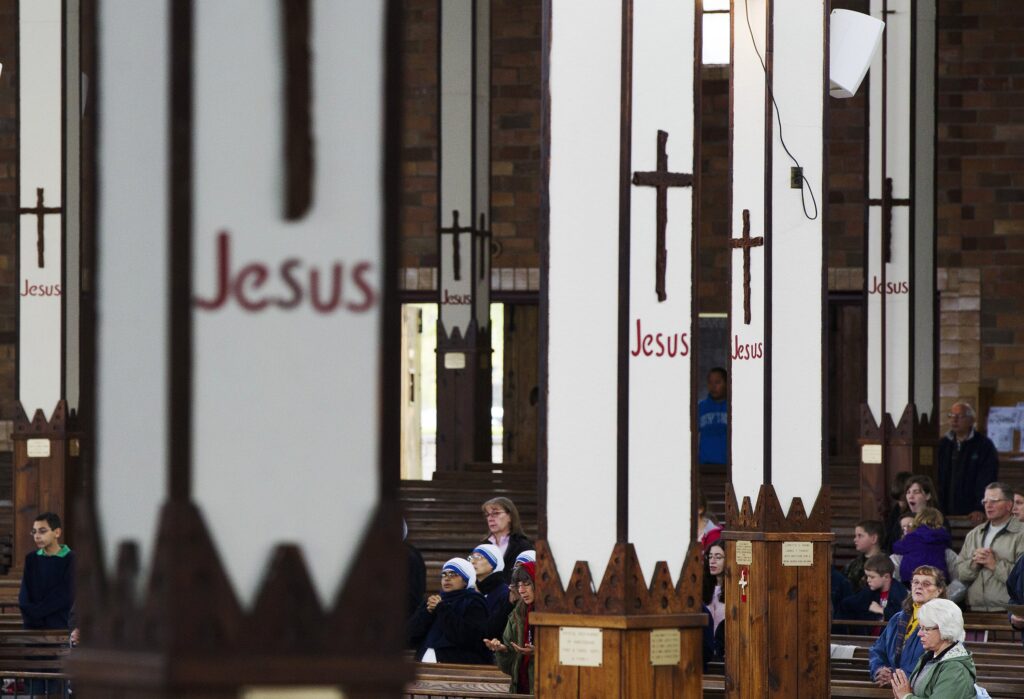Cardinal Timothy M. Dolan, joined by several of New York state’s other Catholic bishops, will celebrate Mass on the second day of the New York State Eucharistic Congress

(OSV News) — An upcoming Eucharistic congress at a shrine in New York state is set to draw some 10,000 pilgrims to “holy ground,” according to the shrine’s executive director, where the heroic witness of Jesuit and Indigenous Catholics — even unto death — was the seed that planted the church.
The New York State Eucharistic Congress takes place Oct. 20-22 at Our Lady of Martyrs Shrine in Auriesville, New York. Participants can register for the congress through a dedicated website at nyseucharisticcongress.org.
Organized by the New York State Catholic Conference, the gathering is part of the National Eucharistic Revival, a three-year campaign launched in 2022 by the U.S. bishops to increase the Catholic understanding of and devotion to Christ’s real presence in the Eucharist.
The revival opened June 19, 2022, on the solemnity of Corpus Christi, a feast that celebrates the Body and Blood of Christ. The initiative will conclude with a National Eucharistic Congress in Indianapolis July 17-21, 2024.
Part of the impetus for the campaign was a 2019 Pew Research Center study showing just three out of 10 Catholics understand and believe in the Real Presence of Jesus in the Eucharist.
Cardinal Timothy M. Dolan, joined by several of New York state’s other Catholic bishops, will celebrate Mass on the second day of the New York State Eucharistic Congress.
Julie Baaki, executive director of Our Lady of Martyrs Shrine, told OSV News the program will also feature daily liturgies, Eucharistic processions, all-night Eucharistic adoration, opportunities for the sacrament of reconciliation, talks, and vendors.
The “historic three-day event” will be “a wonderful time to renew our faith in Jesus, and share that faith with others,” said Bishop Edward B. Scharfenberger of Albany in a March 20 press release issued by the New York State Catholic Conference.
The shrine is a “perfect location” for the congress, with a history that invites a deeper reflection upon the significance of the Eucharist, Baaki told OSV News.
Nestled on the Mohawk River some 40 miles northwest of Albany, the shrine is reputed to be on the site of the 17th-century Mohawk fortified village of Ossernenon. The Mohawk nation, or Kanien’kehá:ka, is one of the Six Nations of the Haudenosaunee (Iroquois) Confederacy.
The shrine first became a formal place of devotion in 1884, when Jesuit Father Joseph Loyzance, pastor of St. Joseph Parish in Troy, New York, purchased 10 acres of what was then a farm and built a small chapel. Father Loyzance named the site “Our Lady of Martyrs” to honor its heritage.
During the 1640s, Sts. Isaac Jogues, René Goupil, and John Lalande, all Jesuit missionaries, were killed at Ossernenon. In 1930, they and five Jesuit contemporaries martyred in Canada were canonized as the North American continent’s first canonized martyrs.
Although not formally canonized, two Wendat (Huron) Catholics, Eustace Ahatsistari and Paul Ononhoraton, also died at Ossernenon. Witnessing heroically under torture to the credibility of the Catholic faith, they prayed for peace and reconciliation between their peoples, instead of vengeance.
By the time of his 1646 death in Ossernenon, St. Isaac Jogues had been adopted into the Mohawk nation’s Wolf Clan, ministering to a nascent Christian community while trying to help maintain a fragile peace between the Mohawk nation and New France. Because the Turtle Clan protected St. Isaac Jogues, some members of the Bear Clan undertook a conspiracy to lure the saint to his death by inviting him to retrieve his Mass kit in their longhouse, after which they subdued Jogues’ Turtle Clan bodyguard and martyred the saint.
However, following these events, the Mohawk nation would see its Catholic community grow as a massive influx of Indigenous Catholics were adopted into their nation, giving the witness of their faith and maintaining a community of prayer.
St. Kateri Tekakwitha, a Mohawk woman whose mother was an Algonquin-born Catholic, was born at Ossernenon in 1656, and grew up witnessing leading Mohawk men and women, as well as their Haudenosaunee cousins in the Oneida nation, embrace the Catholic faith and invite others to commit their lives to follow Jesus Christ with heroic vigor.
Convinced of their witness, and seeking instruction from Jesuit priests, St. Kateri was baptized in 1676. The following year, St. Kateri decided to follow in the footsteps of her sister and other Mohawk Catholics in migrating north to Kahnawake, along the St. Lawrence River in Canada, where it is today. The predominantly Haudenosaunee Catholic village was served by the St. Francis Xavier Mission, where St. Kateri could live her Catholic faith through the beauty of her Mohawk culture. St. Kateri joined the Holy Family Association, whose lay members competed with each other in carrying out the works of the Gospel, and where she lived an intense life of Eucharistic devotion as a consecrated virgin before dying at 24 in 1680.
During and after St. Kateri’s time, Kahnawake produced many Mohawk and Haudenosaunee (Iroquois) Catholic men and women renowned for holiness — including several reputed martyrs — and evangelization. In the 19th century, Mohawk Catholic families spread the Gospel to Indigenous nations across Canada and the northern U.S. to the Pacific coast.
The legacy of the saints is almost palpable at the shrine, said Baaki, noting that one of the Eucharistic processions will wind into the ravine where St. René Goupil is believed to have been martyred, and where fragments of his body — later interred by St. Isaac Jogues — are believed to remain buried.
“The procession will enter into a natural reliquary,” said Baaki.
She noted that hundreds have already registered for the congress, with attendance capped at 10,000. Parking will be centralized, with shuttle buses available from the lots to the shrine grounds. Except for the Eucharistic procession into the ravine, the shrine is easily accessible to persons with disabilities, Baaki said.
While “definitely out in a country area,” the shrine is “pretty centrally located,” with more than enough hotels within a 20-25 minute drive, explained Baaki, adding that the congress will provide both spiritual refreshment and a welcome boost for the local economy.
“Just this event alone is going to make these holy grounds known to the entire state of New York, which we’re so incredibly grateful for,” said Baaki.


